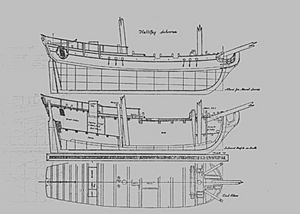HMS Halifax (1768) facts for kids

Plans of HMS Halifax by Howard I. Chapelle
|
|
Quick facts for kids History |
|
|---|---|
| Name | Nova Scotia Packet |
| Port of registry | Halifax, Nova Scotia |
| Launched | Halifax, NS, September 1765 |
| Maiden voyage | Halifax to Boston, 15 October 1765 |
| Fate | Sold to Admiralty in October 1768 |
| Name | HMS Halifax |
| Acquired | October 1768 |
| Fate | Wrecked on 15 February 1775 |
| General characteristics | |
| Tons burthen | 83 4/94 bm |
| Length |
|
| Beam | 18 ft 3 in (5.6 m) |
| Depth of hold | 8 ft 10 in (2.69 m) |
| Propulsion | Sail |
| Sail plan | Square Topsail schooner |
| Complement | 30 |
| Armament |
|
HMS Halifax was a type of sailing ship called a schooner. It was built in Halifax, Nova Scotia in 1765. At first, it was used to carry mail and passengers. Later, the British Royal Navy bought it in 1768. They used it to patrol the coast of North America. This was just a few years before the American Revolution, a big war for independence. The Halifax is special because we have many detailed records about it. This makes it one of the best-known schooners from early North America.
Contents
Nova Scotia Packet: A Busy Mail Service
The schooner was first known as the Nova Scotia Packet. A group of merchants in Halifax built it. They had help from the government. Their goal was to start a regular mail and passenger service. This service would run between Halifax and Boston. It began in 1765.
Joseph Grey was the main owner of the ship. He was related to the head of the Halifax Naval Yard. It's likely the schooner was built right there. The Nova Scotia Packet was launched in late September 1765. Its first trip was on October 15, 1765. Benjamin Green Jnr. was the captain.
The ship sailed every eight days between Halifax and Boston. This depended on the weather. It completed 23 round trips as a merchant ship. In July 1768, a naval officer named Commodore Samuel Hood used the Nova Scotia Packet. He chartered it in Halifax to carry important messages to Portsmouth, England. Hood also suggested that the British Royal Navy should buy the schooner.
The Royal Navy bought the schooner on October 12, 1768. They changed its name to Halifax. The Navy needed more ships like this to patrol the coast. These ships helped fight against smuggling. They also dealt with growing problems in the American colonies, especially in New England.
Naval architects at Portsmouth carefully recorded the ship's design. They also kept detailed records of its service. This is why the Halifax is so important for studying early schooners.
The ship was inspected in September 1768. Then, it was officially put into service in October. It was prepared for duty at Portsmouth between October and December. Its first commander was Lieutenant Samuel Scott. He sailed the Halifax back to North America in January 1769.
In 1769, the Halifax captured another schooner called Liberty. This ship belonged to a famous American, John Hancock. The Liberty later became a British naval ship, HMS Liberty. The Halifax returned to Britain for repairs in December 1770. The next year, Lieutenant Abraham Crespin was its commander.
Lieutenant Jacob Rogers took command in 1773. Then, Lieutenant Joseph Nunn became commander in 1774. By late 1774 and early 1775, the ship was in bad shape. It was leaking and not fit for service. It was ordered to stay anchored in port. A survey was planned for the spring.
The End of HMS Halifax
Shipwreck Near Machias
After serving actively along the North American coast, the Halifax was wrecked. This happened during a strong storm at 3 AM on February 15, 1775. The ship hit Foster Island, near Machias, Maine. That night, it broke apart in a snowstorm.
Reports said that a local pilot intentionally ran the ship aground. The Navy held a court martial for Lieutenant Nunn, his officers, and crew. They blamed the loss on the pilot's lack of knowledge. However, nothing came of this. The pilot had disappeared while Nunn was arranging transport for his crew. He was trying to get them from Sheep's Island to Boston with a local ship owner.
Legacy of the Wreck
The wreck of the Halifax played a small part in the Battle of Machias later that year. Admiral Samuel Graves ordered that the ship's guns be recovered.
There was another schooner named Halifax that served in North America. It was bought in 1775. Its design was the same as the Halifax that sank that year. This means it might have been the same ship, salvaged and put back into service.


